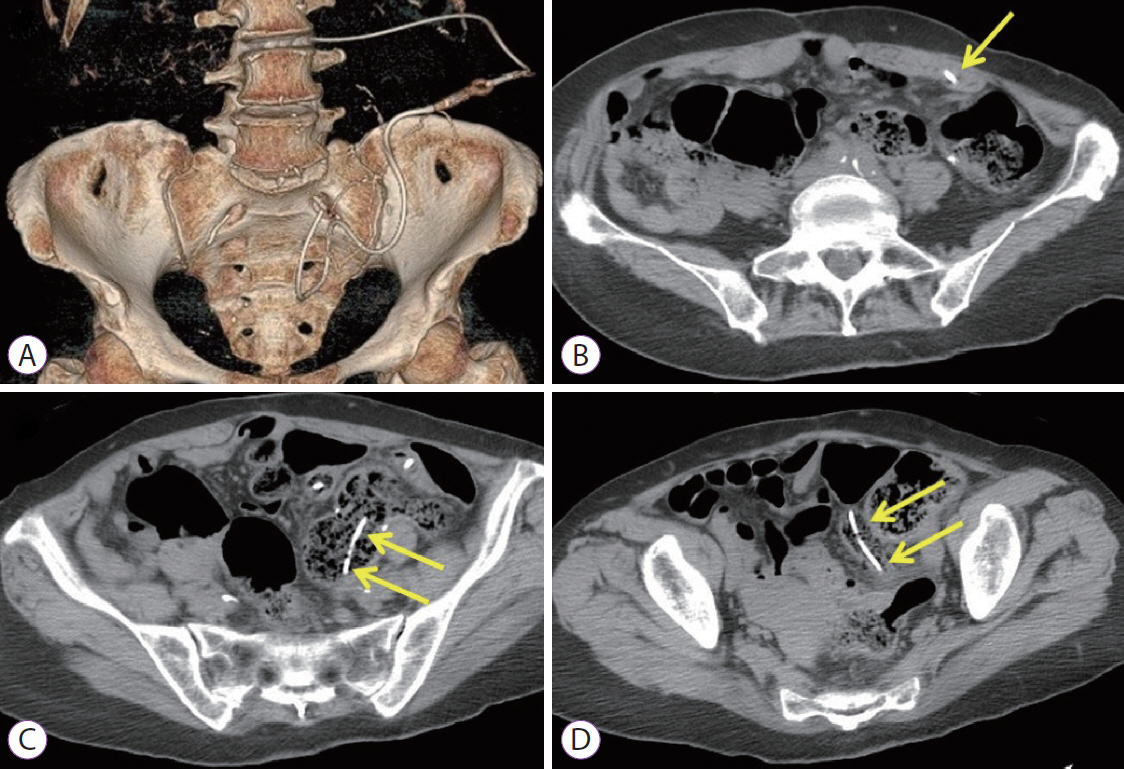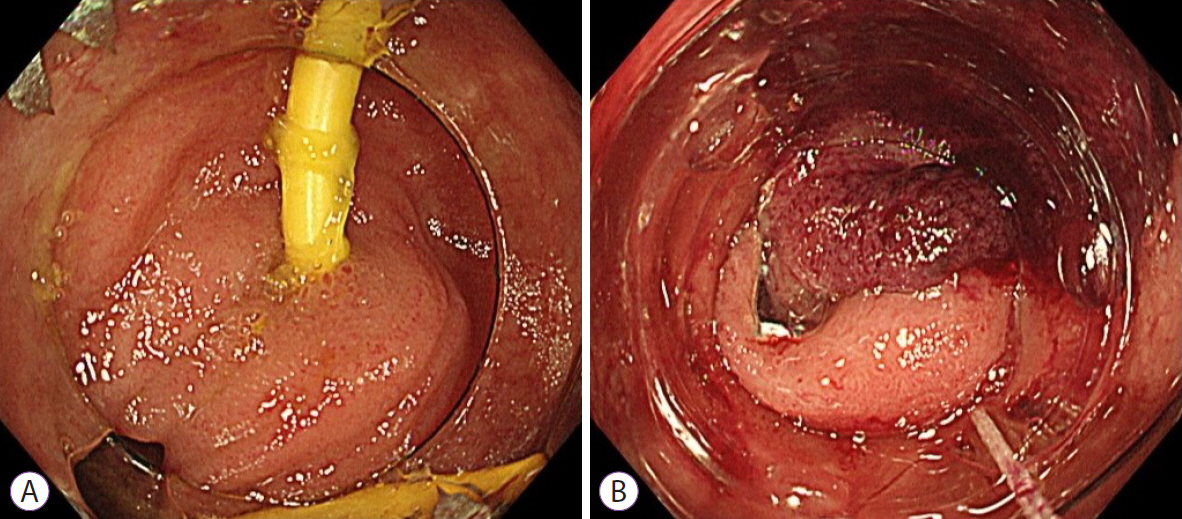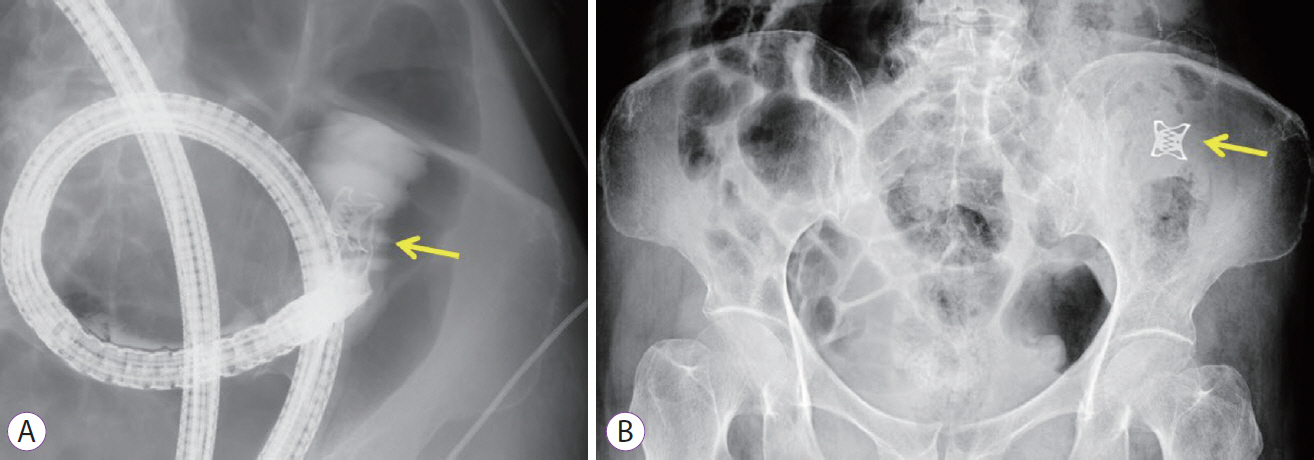Clin Endosc.
2022 Jan;55(1):146-149. 10.5946/ce.2020.293.
Intestinal Perforation Caused by Lumboperitoneal Shunt Insertion Repaired with an Over-the-Scope Clip
- Affiliations
-
- 1Department of Gastroenterology, Nishi-Yokohama International Hospital, 56 Gumizawa-cho, Totsuka-ku, Yokohama, Kanagawa 245- 8560, Japan
- KMID: 2525062
- DOI: http://doi.org/10.5946/ce.2020.293
Abstract
- Lumboperitoneal or ventriculoperitoneal shunt insertion is a standard therapy for hydrocephalus that diverts cerebrospinal fluid from the subarachnoid space into the peritoneal cavity. Gastrointestinal perforations due to this procedure occur rarely; however, accepted treatment strategies have not yet been established. Hence, the most common treatment approaches are open surgery or spontaneous closure without endoscopy. We report the case of a small intestinal perforation in a 73-year-old-woman that occurred after the insertion of a lumboperitoneal shunt. A positive cerebrospinal fluid culture and high cerebrospinal fluid white blood cell count indicated a retrograde bacterial infection, and computed tomography revealed that the peritoneal tip of the shunt catheter was located in the lumen of the gastrointestinal tract. We repaired the perforation endoscopically using an over-the-scope clip, and the patient’s recovery was uneventful. Use of an over-the-scope clip could be an effective and minimally invasive treatment for intestinal perforations caused by lumboperitoneal or ventriculoperitoneal shunt insertion.
Keyword
Figure
Reference
-
1. Sathyanarayana S, Wylen EL, Baskaya MK, Nanda A. Spontaneous bowel perforation after ventriculoperitoneal shunt surgery: case report and a review of 45 cases. Surg Neurol. 2000; 54:388–396.2. Vinchon M, Baroncini M, Laurent T, Patrick D. Bowel perforation caused by peritoneal shunt catheters: diagnosis and treatment. Neurosurgery. 2006; 58:S76–S82.3. Martinez Hernández-Magro P, Barrera Román C, Villanueva Sáenz E, Zavala MJ. Colonic perforation as a complication of ventriculoperitoneal shunt: a case report. Tech Coloproctol. 2006; 10:353–355.4. Sells CJ, Loeser JD. Peritonitis following perforation of the bowel: a rare complication of a ventriculoperitoneal shunt. J Pediatr. 1973; 83:823–824.5. Knuth J, Detzner M, Heiss MM, Weber F, Bulian DR. Laparoscopy for a ventriculoperitoneal shunt tube dislocated into the colon. JSLS. 2013; 17:675–678.6. Chiang LL, Kuo MF, Fan PC, Hsu WM. Transanal repair of colonic perforation due to ventriculoperitoneal shunt--case report and review of the literature. J Formos Med Assoc. 2010; 109:472–475.7. Khater S, Rahmi G, Perrod G, et al. Over-the-scope clip (OTSC) reduces surgery rate in the management of iatrogenic gastrointestinal perforations. Endosc Int Open. 2017; 5:E389–E394.8. Kobara H, Mori H, Nishiyama N, et al. Over-the-scope clip system: a review of 1517 cases over 9 years. J Gastroenterol Hepatol. 2019; 34:22–30.9. Voermans RP, Le Moine O, von Renteln D, et al. Efficacy of endoscopic closure of acute perforations of the gastrointestinal tract. Clin Gastroenterol Hepatol. 2012; 10:603–608.10. Purchiaroni F, Nakajima T, Sakamoto T, Abe S, Saito Y. Over-the-scope-clip pre-mounted onto a double balloon enteroscope for fast and successful closure of post-EMR jejunal perforation: case report. BMC Gastroenterol. 2017; 17:152.
- Full Text Links
- Actions
-
Cited
- CITED
-
- Close
- Share
- Similar articles
-
- Spontaneous Fracture of a Lumboperitoneal Shunt Catheter: A Case Report
- Over-the-Scope Clip in the Treatment of Gastrointestinal Leaks and Perforations
- A Case of Post-Traumatic Pseudomeningocele Treated by Lumboperitoneal Shunt
- Two Cases of Pancreatobiliary Disease Complications Treated Using Over-the-Scope Clip
- Clinical Experience on Lumboperitoneal Shunt




